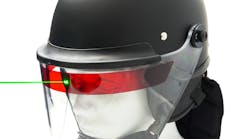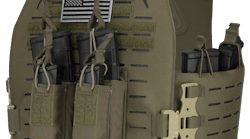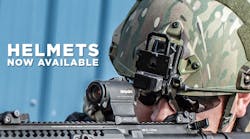Wearable technology means to mount, in some way or another, information gathering devices on your person; there's even technology to strap around a chest or a wrist to report heart rate and stress. What good does that kind of data do for the officer? What good is technology for an officer if not to present that data to more than the monitors in the mobile command center? Today devices send alerts all the time: turn left, new message, an ALPR system flags a license plate. As convenient as these notifications are, data presented forces a head turn. What if technology could minimize if not remove that head turn, that moment where you're no longer looking at the people walking by, no longer watching the road ahead or looking to your radio for the latest information?
In fiction, heads-up displays cover character's faces almost entirely, yet a few real-life high-tech devices are headed this general direction to maximize situation awareness. Augmented-reality (AR) technology is currently being utilized in the military industry, mostly for special operations. Yet, it doesn't take much to see the leap in this technology to display relevant data for a law enforcement officer on patrol or in an intense tactical situation.
Companies developing AR technology either group everything together or split devices into two families: overlaying data in (or over) vs. just outside your vision. In other words, either a transparent screen covers your view or a device hangs off to the side in your peripheral vision.
Out of vision
Earlier this year a few pairs of Google Glasses made their way into the New York Police Department. The Google Glass Explorer program allows anyone to beta-test the devices. Open to everyone, applicants sign up in a simple form and pay a $1,500 fee. Reportedly, as of late May, the law enforcement in Dubai have integrated the Glass product into regular police work to assist in traffic violations as well as act in as LPR. While the NYPD has yet to publish an announcement and judgment, it will be interesting to learn how the few officers were using them: what data was seen, what applications run, what data captured.
Google Glass weighs almost the same as your favorite pair of sunglasses. With a small prism floats over a single eye, it reportedly looks like a 25-inch display sitting eight feet away. There are concerns over eye fatigue as well as issues with eye dominance. The projection itself looks less meant for small report forms and more for alert-based information. Since it connects to the Internet, it may be feasible for a database to use an officer's location and alert them with photos of a known suspect. Perhaps Dubai's officers receive specialized alerts regarding open warrants, photos, reported stolen plates, etc.
A few companies asked themselves these questions and decided to not wait for someone else to be innovative. In a prototype, PublicEngines ported their predictive analytics software, CommandCentral Predictive. Originally intended for tablets and smartphones, "the predictive product is designed to be a tactical tool to help law enforcement officers by giving them information about where they should be focusing their time and effort while in the field as well as giving them the essential information that they need to make tactical decision while they're there," says William Kilmer, CEO of PublicEngines. "How do we provide [information] to the officer without sticking another device in their hands? What does it really look like to enable an officer in a way that that information is just presented instantly without them having to pick something up, sign on, look at directly. Google Glass is just a very convenient way for us to supply information for the officer to request additional information, and for it to be provided to them that's completely hands off," he adds.
In September 2013, CopTrax from Stalker Radar ported its software into a Glass application in a field test operation aptly named "Futuristic Police Officer." In a press release, one of the evaluating police officers reports that the device "was not an impairment at all." It was tested on patrol using radar and laser, in traffic stops, arrests, as well as firing their firearm.
Public safety, however, doesn't need to rely on massive companies such as Google to provide AR solutions, there are alternatives. The MC1 headset computer, for example, from Motorola Solutions, looks to provide vital information to its wearer when a laptop or handheld device is impractical. Among other uses, MSI sees potential in SWAT, live training, emergency medical technicians, security as well as an alternative MDT in a patrol car.
The concept behind the Vuzix M100 Smart Glasses product seems to be similar to the MC1. Their current version can mount to a pair of safety glasses (a headset mount is available) to display what looks like, according to the Vuzix website, "a four inch smartphone held at a typical 14 inch distance." The M100 glasses are being introduced by Six-15 Technologies to the defense, homeland security and first responder markets.
Neither the MC1 nor M100 are transparent - blocking what could be behind it while your eye is focused. These product do bring up a decent question, is transparency a requirement for AR?
In-vision
In 2008-09 Applied Research Associates Inc. (ARA) won a competition with DARPA to develop an AR software program for soldiers to wear in the battlefield. While working with BAE on the project, what resulted was the Q-Warrior system (the hardware) and ARC4 (the software). Continuing phases of the competition shrank the device, the most updated helmet-mounted kit runs roughly two pounds and about the size of a cell phone. Its see-through display covers 100% of your vision.
Jennifer Carter, a Senior Scientist at ARA, says "the whole design of the system is meant to lower cognitive load so the people wearing this can actually do their job." The ARC4 software places geo-registered icons overlaid on an officer's real-world view. A T3D ring projected at the lower part of your "sight" visually shows a virtual compass using data from sensors - an effort to help orientation. The software is capable of virtually "tagging" items and representing them as icons in your vision.
A press kit describes the ARC4 software as "transforming your view of the world with digital tags that persist as if painted on physical objects," or "virtual graffiti." Fellow law enforcement officers could be tagged in tactical operations, known suspect locations could be marked on a virtual map - ARC4's software moves these icons around based on where you're looking. An officer would be able to know locations of backup even when out of sight, in the other room, the other side of the building, etc. ARC4 is display agnostic and can be adapted to other display devices.
AR may have also found a landing zone in the aviation patrol. Expected to be on the market late 2016, Elbit System's SKYLENS wearable head-up display is a part of an enhanced flight vision system application. The goggle-like device looks to display vital information for pilots, overlaying the data in sight all while not impairing their real-world vision. As a part of the Clearvision Enhanced Flight Vision System family, SKYLENS would display high resolution symbology and video on a transparent visor, providing pilots with cutting edge head out capabilities.
With no known current public safety applications at this time, Oculus Rift's DK2 seems to be more directed towards the gaming industry. Essentially it puts a monitor inches away from your face encapsulating your entire vision, one for each eye, creating an artificial depth perception. A motion sensor tracks your head movement, your hands use well-known controls. Videos of users becoming dizzy virtually riding roller coasters and solving complex puzzles are abound on YouTube. Wearers would not see the real world, just a projected screen. With further development, could PSAPs years from now be filled with operators interacting with a virtual-reality based 911 software?
"There's so many applications that I think those together can make a very compelling capability over the next few years," Kilmer says. He also sees an opportunity for AR-based devices to have a cost-saving aspect. One agency, Kilmer explains, prints off 8,000 sheets of paper every day to disseminate the agency's proprietary predictive solution. With highly mobile devices, any information can be instantly provided and recall. "Any of these devices can pay for themselves overtime," he says.
Augmented-reality may sound so futuristic that it hardly could be reality: idealistic robotic officers, bio-mechanical eyes glowing red. Realize AR technology has been around for decades. Night vision devices take your perspective and overlay "new" data onto your sight. Officers may not be wearing these goggles walking down the street, while on a low-light operation technology augmenting their reality is already in common use, and getting smaller year-by-year. AR seems to be taking that concept to the next - evolutionary - stage.
Editor's Note: In no way does this article report to be an all inclusive list of all AR devices commercially available or in development.



